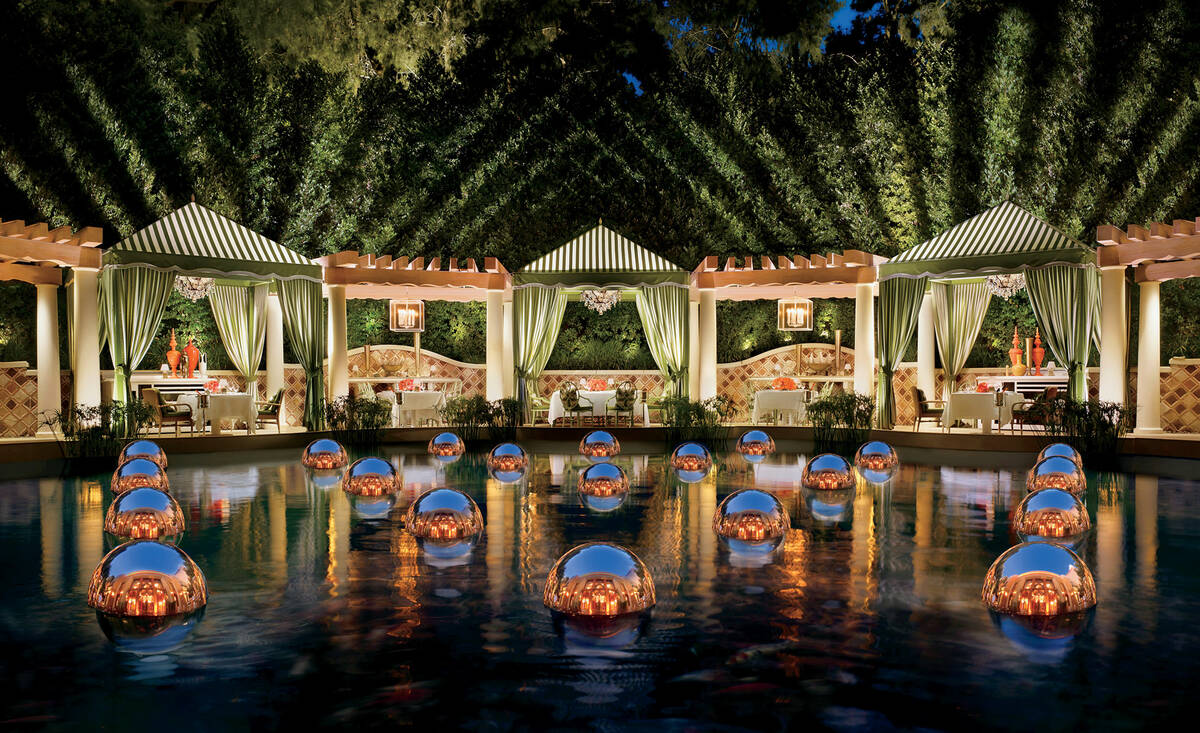The only casino with chandeliers over gaming tables: Behind the extravagant design at Wynn

The evocative architecture of Wynn Resorts has long stood out in person and in photos, but a new book highlights the grand lobbies, giant lampshades and glossy finishes that define Roger Thomas’ impact on the luxury hotel-casino brand.
Thomas, the lead designer behind Wynn and Encore, among other properties, recently released his first book, “Resort Style: Spaces of Celebration.” Publisher Rizzoli calls the 256-page book a “gold-embellished tome” that explores Thomas’ emotive design themes.
The Review-Journal spoke with Thomas recently about his design philosophy and book. This interview has been edited for length and clarity.
Review-Journal: Tell me in your own words what people should know about your design at Wynn Resorts.
Thomas: Wynn Resorts was the last 20 years of a 40-year career designing for Steve and Elaine Wynn. They were my only clients, I was in-house so we knew each other very well.
When we came to Wynn Resorts, my favorite words ever that Steve said were, “I want this to be something no one has ever seen before.” Which meant that I had to invent a here-to-before unseen vocabulary of design. I understood that my assignment was not to go shopping for the most beautiful stone and wood and textile. My assignment was to create such an evocative emotional experience that our guests would be surrounded with it. If it was truly unique, they would want to return for more.
I asked myself, “How can I create drama in this space? What’s going to make that feeling of joy? What’s going to make it joyful? What kind of mystery can we inflict? What should we not do here? What should we absolutely not do here? Let’s do that and create surprise.”
I use design elements to tell a story like you do and in the end, that story is supposed to evoke a feeling in the guest of feeling their best selves and feeling illuminated and informed, feeling sophisticated and worldly, yet completely comfortable – whether they’re experiencing that vocabulary wearing a tuxedo or a pair of jeans.
What’s featured in your book?
It’s my past 20 years. It begins with Wynn Las Vegas, which established the vocabulary, and moves on to Encore Las Vegas, Wynn Macau, Encore Macau, which was my studio’s invention. Wynn Palace (in Cotai), and finally, the finale of Encore Boston.
Many of the spaces actually that are in the book no longer exist. The restaurant Alex was created for a dining experience that was en vogue then, which took four hours. No one has the patience for it now. Everybody wants an Instagrammable moment, a quick cocktail to give them a buzz, some food they can photograph and make your friends jealous over and they’re onto the next set of photographs.
How do you find balance in approaching the spectrum of guests and evoking the same feelings in them?
One of the main problems in building any project of the scale of the Las Vegas hotel is intimacy. I use an enormous amount of detail, and human-scale detail, to make everyone feel more comfortable and more individual.
For instance, Wynn is the only hotel-casino that has chandeliers over the gaming table. That was done so that it wouldn’t be a blackjack table, it’d be your blackjack table. To do that, we had to spend over a quarter of a million dollars developing a chandelier that proved to the Nevada Gaming Control Commission that it not only did not obscure the security cameras, because it contains its own security camera, which we patented, it improves the security of the table.
What I’m hearing is it’s all in the details and letting the quality work speak for itself.
Right, and it requires not only selecting the right designer, it requires management to have the vision and discipline to spend time with that designer. When I would present a restaurant, it wasn’t to Steve and Elaine alone. It was also to the restaurant manager and the hotel manager. Those guys have other things to do, but the result was a much better restaurant.
We would have meaningful productive conversations about how to improve the experience. Steve always said to every designer and to every one of his executives and every single member of his staff, even the guy who’s bringing your luggage to your room, “Think like the guest.”
There’s a significant increase in luxury hotel plans and projects on the Strip. Do you have any thoughts on the future of design in Las Vegas for these potential resorts – how can they be unique?
I don’t see anybody developing luxury resorts in the way that Steve Wynn was able to do, and the magic of Steve and Elaine working together. I think their understanding of the word “luxury” and ours differs. They’re trying to create experiences for which they can charge a lot, and that’s not what we were doing.
(Steve and Elaine Wynn) were both there to refine the service. We really drilled down on absolutely everything. Luxury often is said to be being able to afford many wonderful choices. I believe, and Steve concurred with me, that luxury is having thousands of choices made for you — all done correctly.
McKenna Ross is a corps member with Report for America, a national service program that places journalists into local newsrooms. Contact her at mross@reviewjournal.com. Follow @mckenna_ross_ on X.